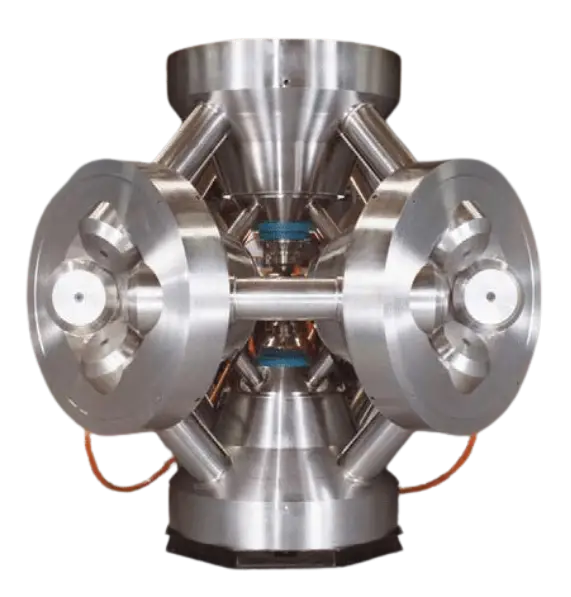How High Pressure and High Temperature Create Lab-Grown Brilliance
Lab-grown diamonds have revolutionised the jewellery industry, offering brilliance that’s chemically, physically, and optically identical to mined diamonds.
And one of the methods that makes this possible is High Pressure, High Temperature (HPHT).
This process recreates the conditions under which diamonds are formed deep within the Earth—except it happens in a lab, where humans control every step of the way.
How It All Begins: The Diamond Seed
Every HPHT diamond starts with a diamond seed – a tiny sliver of an existing diamond. This seed acts as the foundation for the new diamond, much like a grain of sand forms the base of a pearl.
The seed is placed into a controlled chamber that replicates the extreme conditions found 100 miles beneath the Earth’s surface, where natural diamonds form.
The HPHT Process: Diamonds Under Pressure
The HPHT method works by exposing the diamond seed to extreme pressure and temperature to encourage carbon atoms to crystallise into a diamond structure. Here’s how it happens:
- The Setup:
- The diamond seed is placed into a growth chamber along with carbon-rich materials, usually graphite.
- A metallic catalyst (often iron, nickel, or cobalt) is added to help the carbon atoms bond into a diamond structure more efficiently.
- Pressure and Heat:
- The chamber is subjected to temperatures of 1,300–1,600°C and pressures of 5–6 GPa (that’s around 70,000 times the atmospheric pressure at sea level!).
- Under these conditions, the carbon begins to melt, and the atoms migrate toward the diamond seed, slowly crystallising into a larger diamond over time.
- Crystal Growth:
- Over the course of several weeks, the carbon atoms build upon the seed in a cubic crystal structure, forming a rough diamond.
The process mimics the Earth’s natural diamond formation but significantly speeds it up—what takes millions of years underground happens in a matter of weeks in a lab.
Environmental Impact: Is HPHT Sustainable?
Lab-grown diamonds are often celebrated as a more sustainable alternative to mined diamonds, but HPHT does have some environmental considerations:
- Energy Use: The HPHT process is energy-intensive, as it requires maintaining extreme heat and pressure for extended periods. However, labs that use renewable energy significantly reduce this impact.
- Water Usage: HPHT consumes minimal water compared to diamond mining, which can require millions of litres.
- Carbon Footprint: While lab-grown diamonds have a lower carbon footprint overall, HPHT’s high energy requirements may result in slightly higher emissions than other methods (like CVD), unless powered by clean energy.
The Upside: HPHT avoids the devastating environmental damage of diamond mining—no deforestation, no soil disruption, and no displaced communities.
What They Look Like When They’re Done
Once the growth process is complete, HPHT diamonds are:
- Rough and Cubic: The resulting diamond has a rough, metallic-looking exterior with a distinct cubic shape, often reflecting its growth under HPHT conditions.
- High Clarity Potential: HPHT diamonds often have fewer internal inclusions compared to natural diamonds because the growth environment is controlled.
- Natural Colour Variations: HPHT diamonds may have slight yellow or brown undertones due to the metallic catalyst used. These can be corrected with post-growth treatments.
Post-Growth Treatments: Fine-Tuning Perfection
While HPHT diamonds are stunning when grown, some stones may require additional treatment:
- Colour Correction: If the diamond develops slight yellow or brown tints during growth, it can be treated with HPHT annealing – essentially exposing it to further heat and pressure to improve colour.
- Clarity Improvements: In rare cases, laser drilling or other techniques may be used to reduce visible inclusions.
Most high-quality HPHT diamonds undergo minimal treatment, and their clarity and brilliance rival the very best natural diamonds.
How Long Does It Take?
The HPHT process typically takes 2 to 4 weeks to produce a gem-quality diamond, depending on the desired size and conditions in the chamber. Larger diamonds require more time to grow and maintain crystal stability.
Benefits and Drawbacks of HPHT Diamonds
Benefits of HPHT:
- Exceptional Quality: HPHT diamonds often exhibit high clarity and brilliance when grown under the right conditions.
- More Affordable: HPHT diamonds are typically less expensive than natural diamonds of comparable size and quality.
- Mimics Nature: The process is as close as it gets to how diamonds form in the Earth.
Drawbacks of HPHT:
- Colour Challenges: Metallic catalysts can sometimes cause faint yellow or brown hues, though post-growth treatments can resolve this.
- Energy-Intensive: HPHT requires significant energy, making it slightly less sustainable unless clean energy sources are used.
- Size Limitations: While HPHT can produce stunning diamonds, growing very large stones can be more challenging compared to other methods like CVD.
Who Should Choose an HPHT Diamond?
If you love the idea of a diamond grown in a way that mimics nature and want exceptional clarity and quality, an HPHT diamond is a beautiful, meaningful choice. Plus, it’s often a more affordable and sustainable alternative to mined diamonds, giving you luxury without compromise.
The Adamas Studio Take
The HPHT process is a marvel of science, delivering diamonds that are just as brilliant and durable as those formed deep within the Earth—only faster, cleaner, and kinder. Whether you’re searching for a perfectly colourless stone or a diamond with a touch of vintage warmth, we’ll help you find the perfect HPHT-grown diamond to suit your style and values.
Ready to explore diamonds grown under the pressures of brilliance? Let’s craft something timeless, ethical, and unmistakably yours. 💎✨





Pingback: achat kamagra aut rabais
Pingback: purchase enclomiphene buy germany
Pingback: ordering androxal purchase in the uk
Pingback: buy flexeril cyclobenzaprine generic pharmacy in canada
Pingback: pfizer dutasteride canada
Pingback: purchase gabapentin new zealand buy online
Pingback: buying fildena cheap where
Pingback: buying itraconazole no rx needed
Pingback: how to buy avodart cost uk
Pingback: order xifaxan generic pharmacy usa
Pingback: cheapest buy rifaximin low price
Pingback: kamagra přes přepážku
united statesn online casinos real money, claiming gambling winnings in united kingdom and best online real can you
make money from matched betting without free bets (Leslie) slots new zealand,
or are there casinos in usa